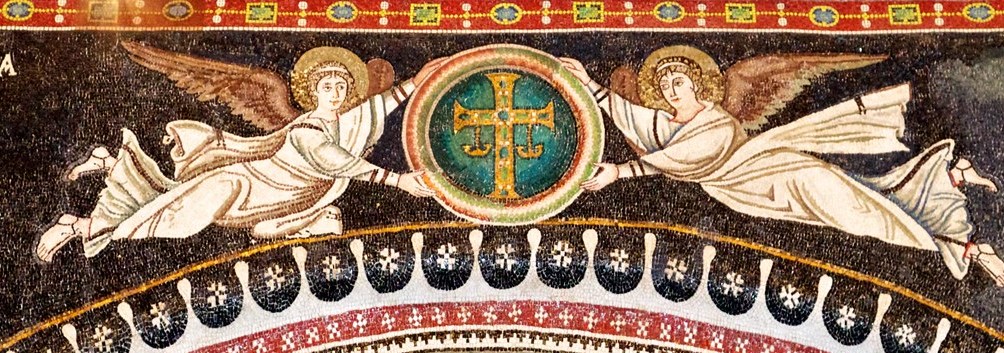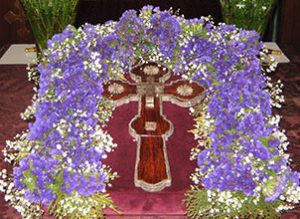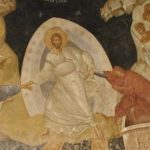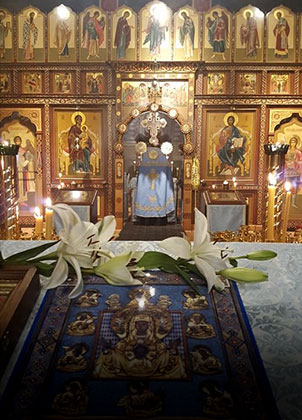The rite of the Exaltation of the Cross.
The origin of this rite goes back to the events of the finding of the true Cross by St Helen, the mother of St Constantine, the first Christian emperor. This took place in Jerusalem, in 326.
Here is the description by St Dimitry of Rostov:
“The multitude was so great that many were unable to see and venerate the true Cross, and they asked if they could see it at least from afar. Then Patriarch Makary, having stood on an elevated place, lifted up the Cross, showing it to people, while they were crying out: ‘Lord have mercy’. And since then the feast of the Exaltation of the Cross has begun.”
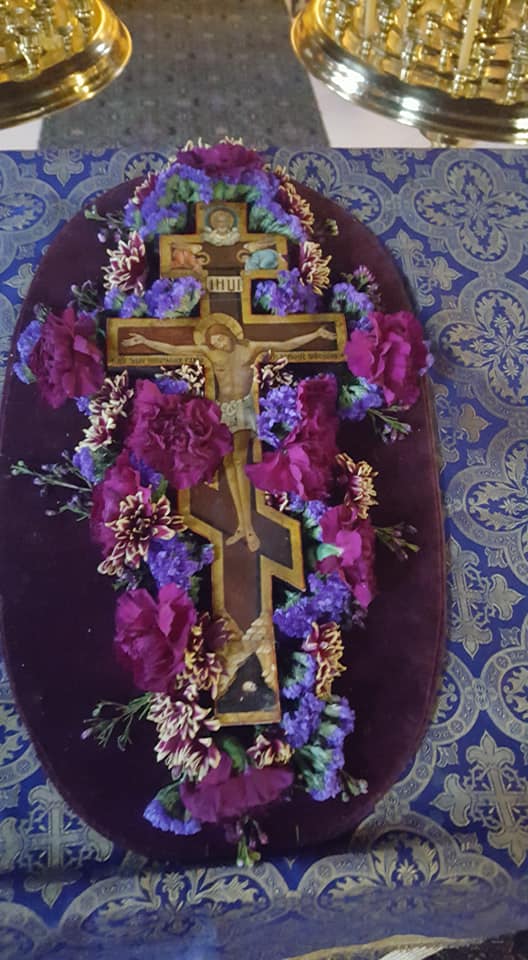
This is how this rite is performed: the bishop blesses the faithful with the Cross, then raises it up and slowly lowers it until the Cross almost touches the ground. Then the bishop gradually lifts the Cross up above the heads of people and blesses them thrice. This action is done to all sides: east, west, south and north. During this the choir sings “Lord have mercy” many times.
What is the meaning of these sacred action? – Church services speak in the language of symbols. While watching the exaltation of the Cross, we should try to penetrate with our heart the significance of this sacred action.
The Cross of Christ is the instrument and symbol of the salvation of man; therefore, in its exaltation and abasement we may see a symbolic picture of the divine plan of our salvation, the essence of our faith.
The Cross is exalted to all four sides of the world: east and west, south and north, because by the Cross the salvation has been wrought for the whole world. “All the ends of the earth have seen the salvation of our God.” (Ps. 98)
Two servers support the hands of the bishop, – this reminds us of the ancient event, described in the book of Exodus. Joshua fought with Amalek in the ravine, while Moses, standing on the top of a hill, was lifting up his hands.
“When Moses held up his hands, Israel prevailed; and when he let down his hands, Amalek prevailed. But Moses’ hands became heavy; so…Aaron and Hur supported his hands, one on one side, and the other on the other side; and his hands were steady until the going down of the sun. So Joshua defeated Amalek and his people with the edge of the sword.” (Ex. 17).
The interpreters of the Bible see in this description a foreshadowing of Christ’s crucifixion. In the canon of the feast we sing:
“Of old, Moses, standing between the priests, prefigured in himself the image of Christ’s most pure sufferings; for, forming a cross with his outstretched arms, he raised up victory, vanquishing the might of the tyrant Amalek…” (Canon 1st ode)
When the Cross, from high, is lowered almost to the ground, we recall the fall of our forefathers, Adam and Eve, which happened through the tree of Paradise. We remember their expulsion from blessedness in Paradise to a sorrowful life on earth, and then their captivity in Hades.
When the Cross is raised up again, we understand that by Christ’s Cross mankind has been led out of the captivity of the devil and risen up to heaven.
Watching the Cross being lowered down to earth, we think of the self-abasement of the Son of God Jesus Christ, Who came down from the heavens and “emptied Himself” having been born on earth from the Holy Virgin Mary. Then through His death on the Cross He went down to Hades to lead out the souls of the captives. When the Cross is lifted up we imagine Christ’s resurrection and ascension to heaven.
Watching this sacred action we again and again exclaim: ‘Lord have mercy,” with repentance for our sins and thankfulness for our salvation wrought for us through the Cross of Christ. The rite of the Exaltation of the Cross clearly depicts that through the pride of the first man Adam, abasement and fall came, on the contrary, through extreme humiliation of Christ’s Cross comes eternal heavenly glory.
“Let this mind be in you which was also in Christ Jesus, Who, being in the form of God…, emptied Himself taking the form of a servant, and coming in the likeness of men… He humbled Himself and became obedient to the point of death, even the death of the cross. Therefore God also has highly exalted Him and given Him the name which is above every name, that at the name of Jesus every knee should bow, of those in heaven, and of those on earth, and of those under the earth, and that every tongue should confess that Jesus Christ is Lord, to the glory of God the Father.” (Philip. 2)
Amen.
Bishop Andrei

